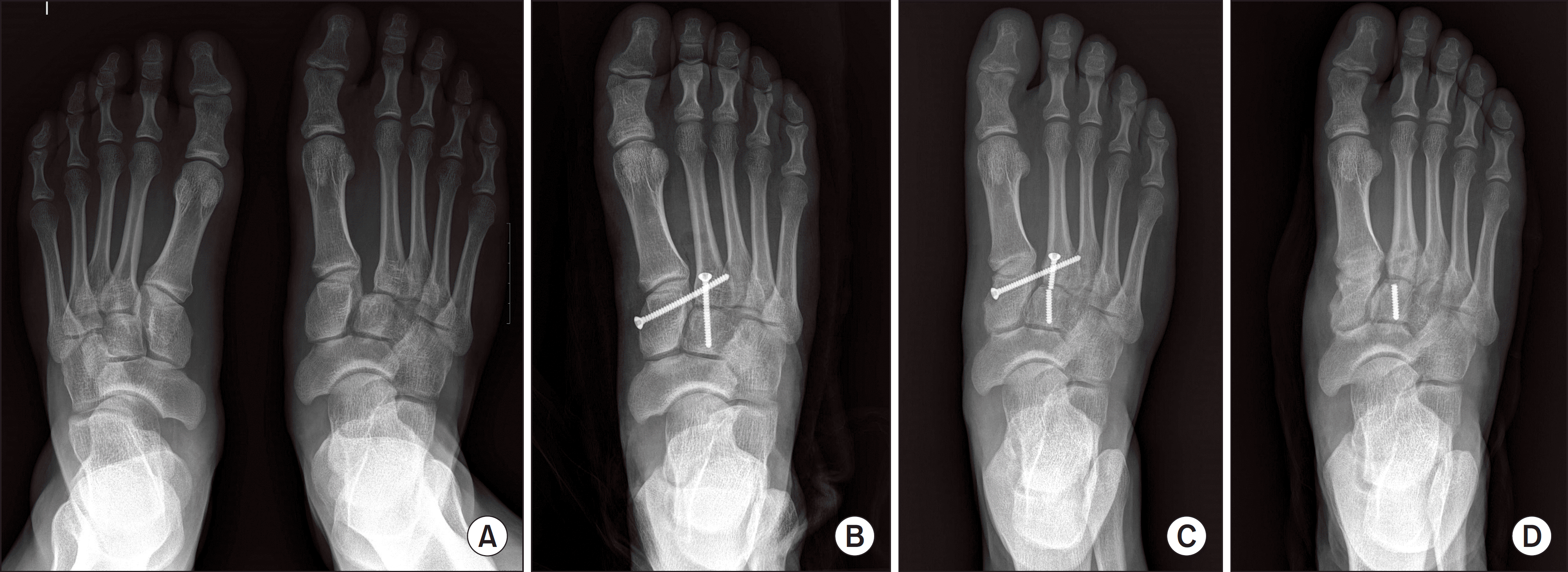Abstract
Purpose
The purpose of this study is to retrospectively analyze the clinical results of screws and Kirschner wire (K-wire) fixation in patients with fracture dislocation of Lisfranc joint and the consequence of screw breakage.
Materials and Methods
Sixty patients underwent Lisfranc joint open reduction and removal of internal fixators from January 2007 to December 2011. Forty-nine cases (81.7%) underwent operations with screw alone, and 11 cases (18.3%) underwent operations with both screws and K-wires. Type of internal fixators, duration of internal fixator removal, breakage of internal fixators and satisfaction with reduction were investigated. Additionally, American Orthopaedic Foot and Ankle Society (AOFAS) midfoot scales were analyzed.
Results
The internal fixator was broken in 5 cases (8.3%). The average duration of instrument removal was 154 days in the non-broken screw group and 268.6 days in the broken screw group (p<0.05). The average AOFAS midfoot scale was 77.4 in the non-broken screw group and 74.2 in the broken screw group. The most commonly damaged portion was the first tarsometatarsal (Lisfranc) joint.
References
1. Trevino SG, Kodros S. Controversies in tarsometatarsal injuries. Orthop Clin North Am. 1995; 26:229–38.

2. Thordarson DB, Hurvitz G. PLA screw fixation of Lisfranc injuries. Foot Ankle Int. 2002; 23:1003–7.

3. Meyer SA, Callaghan JJ, Albright JP, Crowley ET, Powell JW. Midfoot sprains in collegiate football players. Am J Sports Med. 1994; 22:392–401.

4. Nunley JA, Vertullo CJ. Classification, investigation, and management of midfoot sprains: Lisfranc injuries in the athlete. Am J Sports Med. 2002; 30:871–8.
5. Brin YS, Nyska M, Kish B. Lisfranc injury repair with the Tight-Rope device: a short-term case series. Foot Ankle Int. 2010; 31:624–7.

6. Alberta FG, Aronow MS, Barrero M, Diaz-Doran V, Sullivan RJ, Adams DJ. Ligamentous Lisfranc joint injuries: a biomechanical comparison of dorsal plate and transarticular screw fixation. Foot Ankle Int. 2005; 26:462–73.

7. Myerson MS, Fisher RT, Burgess AR, Kenzora JE. Fracture dislocations of the tarsometatarsal joints: end results correlated with pathology and treatment. Foot Ankle. 1986; 6:225–42.

8. Bloome DM, Clanton TO. Treatment of Lisfranc injuries in the athlete. Tech Foot Ankle Surg. 2002; 1:94–101.

9. Cassebaum WH. Lisfranc fracture-dislocations. Clin Orthop Relat Res. 1963; 30:116–29.
10. Fischer LP. Jacques Lisfranc de Saint-Martin (1787–1847). Hist Sci Med. 2005; 39:17–34.
11. Peicha G, Labovitz J, Seibert FJ, Grechenig W, Weiglein A, Pre-idler KW, et al. The anatomy of the joint as a risk factor for Lisfranc dislocation and fracture-dislocation: an anatomical and radiological case control study. J Bone Joint Surg Br. 2002; 84:981–5.
12. English TA. Dislocations of the metatarsal bone and adjacent toe. J Bone Joint Surg Br. 1964; 46:700–4.

13. Vuori JP, Aro HT. Lisfranc joint injuries: trauma mechanisms and associated injuries. J Trauma. 1993; 35:40–5.

14. Korres D, Psicharis I, Gandaifis N, Papadopoulos E, Zoubos A, Nikolopoulos K. Outcome after anatomic reduction and transfixation with Kirschner wires of Lisfranc joint injuries. Eur J Orthop Surg Traumatol. 2003; 13:85–90.

15. Owens BD, Wixted JJ, Cook J, Teebagy AK. Intramedullary transmetatarsal Kirschner wire fixation of Lisfranc fracture-dislocations. Am J Orthop (Belle Mead NJ). 2003; 32:389–91.
16. Pérez Blanco R, Rodríguez Merchán C, Canosa Sevillano R, Munuera Martínez L. Tarsometatarsal fractures and dislocations. J Orthop Trauma. 1988; 2:188–94.
17. Kuo RS, Tejwani NC, Digiovanni CW, Holt SK, Benirschke SK, Hansen ST Jr, et al. Outcome after open reduction and internal fixation of Lisfranc joint injuries. J Bone Joint Surg Am. 2000; 82:1609–18.

18. Mulier T, Reynders P, Sioen W, van den Bergh J, de Reymaeker G, Reynaert P, et al. The treatment of Lisfranc injuries. Acta Orthop Belg. 1997; 63:82–90.
19. Brunet JA, Wiley JJ. The late results of tarsometatarsal joint injuries. J Bone Joint Surg Br. 1987; 69:437–40.

21. Lakin RC, DeGnore LT, Pienkowski D. Contact mechanics of normal tarsometatarsal joints. J Bone Joint Surg Am. 2001; 83:520–8.

22. Reid JJ, Early JS. Fractures and dislocations of the midfoot and forefoot. Rockwood CA, Green DP, editors. Rockwood and Green's fractures in adults. 7th ed.Philadelphia: Lippincott Williams & Wilkins;20101. p.p. 12110–40.
Figure 1.
Broken screw case. (A) Preoperative anteroposterior (AP) weightbearing radiograph is shown for a patient with fracture dislocation of Lisfranc joint. (B) Postoperative AP radiograph shows well reduced Lisfranc joint with two screws. (C) AP radiograph shows broken screw. (D) Postoperative AP radiograph shows broken screw remnant in middle cuneiform bone.

Figure 2.
Non-broken screw case. (A) Preoperative anteroposterior (AP) nonweightbearing radiograph is shown for a patient with fracture dislocation of Lisfranc joint. Lateral partial incongruity of second tarsometatarsal joint was noted. (B) Postoperative AP radiograph shows well reduced Lisfranc joint with multiple screws. (C) All screws are removed. Lisfranc joint shows good congruity.

Table 1.
Patients, Injury, and Treatment Characteristics
Table 2.
Details of Breakage Case
Table 3.
Comparison of Parameters in Both Groups
| Parameter | Group I | Group II | p-value |
|---|---|---|---|
| Age (yr) | 50.0 (26∼74) | 42.1 (14∼76) | 0.74 |
| Sex (male:female) | 4:1 | 40:15 | 0.55 |
| BMI (kg/m2) | 23.6 (23∼25) | 23.9 (22∼26) | 0.57 |
| AOFAS midfoot scale | 74.2 (69∼81) | 77.4 (46∼94) | 0.82 |
| HWR period (day) | 268.6 (189∼453) | 143.9 (100∼324) | 0.02* |




 PDF
PDF ePub
ePub Citation
Citation Print
Print


 XML Download
XML Download